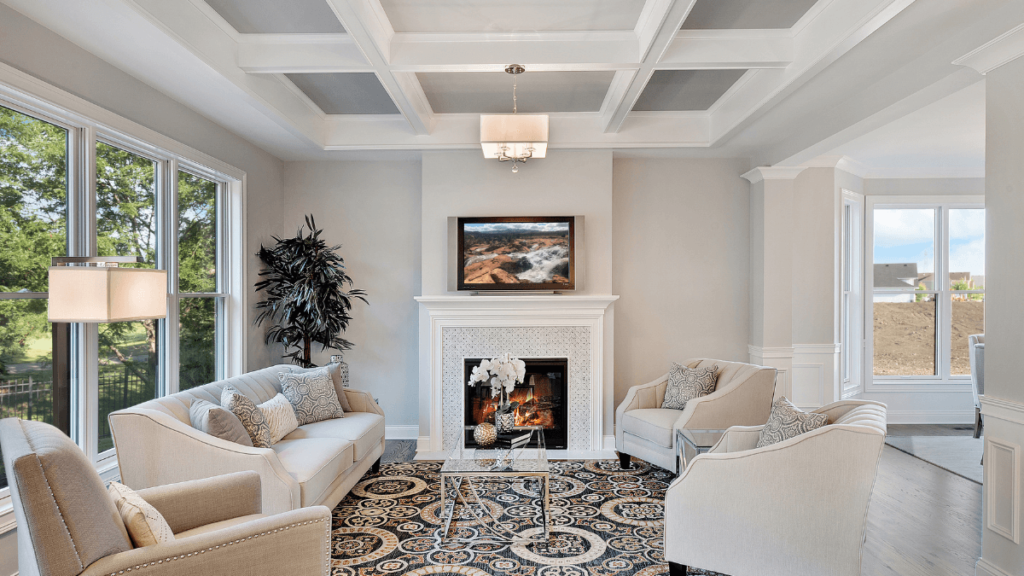Introduction
Lighting is key to creating the perfect ambience in any room of your home. From setting the mood to making a room appear brighter or cosier, lighting can play a big role in transforming a space. But with so many options out there, it can be overwhelming to know where to start. So, we’ve broken it down for you: here are 5 steps to set the perfect lighting for any room in your home. From assessing your space to selecting the right fixtures, we’ve got you covered. By following these 5 tips, you’ll be able to create a welcoming atmosphere that suits your style and needs. Read on to learn how to transform your home’s ambience through your lighting choices.
Reasons why lighting is essential for your home
Lighting is an essential element when it comes to designing and decorating your home. It has a significant impact on the ambience of your living space, and it shapes the mood and emotions that you feel while staying in your home. In addition, it allows you to see and perform different activities without straining your eyes. Proper lighting also enhances the appearance of your home by highlighting its architectural features and accents. A well-lit home creates a warm and welcoming atmosphere for family members and guests, and it is a cost-efficient way to put together a stylish and comfortable living environment. Not only does it have functional benefits, but lighting can also evoke feelings of tranquillity, happiness, and productivity. Therefore, lighting is an essential aspect that needs to be considered when it comes to designing and decorating your home.
5 Lighting Tips
Step 1: Determine the room’s function

A. Consider the purpose of the room
Before setting the perfect lighting for any room in your home, it is important to consider the primary purpose of the room. This will help you determine the type of lighting you should choose, such as whether you need bright, task-oriented lighting for a workspace, or soft, ambient lighting for a relaxation area. For example, in a home office, you may want to select task lighting that illuminates your work and reduces glare on the computer screen. In a living room or bedroom, you may prefer a combination of ambient and accent lighting to create a comfortable and inviting atmosphere. Taking the time to assess the purpose of the room can help you make informed decisions when selecting lighting fittings, bulbs, and other lighting components. By following the steps to set the perfect lighting for any room in your home, you can create a space that not only looks beautiful but also functions well for your needs.
B. Identify the activities that take place in the room
The room is a versatile space that appears to accommodate various activities. At first glance, it is evident that the space is utilized for relaxation, entertainment, and work purposes. The furniture arrangement indicates that the room is designed for both casual and formal settings. There is a couch, a coffee table, and a TV unit that imposes a cosy ambience. On the contrary, a desk and a chair regulate a formal vibe. The lighting plays a fundamental role in enhancing the room’s mood and functionality. According to the ‘Steps to Set the Perfect Lighting for Any Room in Your Home,’ the room’s lighting should not only be aesthetically pleasing but also appropriate for the activities being carried out. Therefore, it is essential to identify the different activities that take place in the room to set the appropriate lighting.
C. The type of lighting required for different activities in the room
Any Room in Your Home includes understanding the type of lighting required for different activities in the room. For example, in a living room, it is important to have a combination of natural lighting, focus lighting, and accent lighting. The natural lighting provides a general light source for the room while reading lighting is meant for specific tasks such as reading or working. Accent lighting adds depth and dimension to the room by highlighting artwork or other decorative pieces. In the bedroom, soft ambient lighting can create a calming and relaxing environment, while focus lighting on the bedside table can provide the necessary light for reading or working. In the kitchen, bright focus lighting is essential for meal preparation, while dimmer soft lighting can create a cosy atmosphere for entertaining guests. Understanding the different types of lighting needed for various activities can help you create a comfortable and functional space in your home.
Step 2: Consider the natural light

A. Observe the room’s natural lighting
One important step is to observe the room’s sunlighting. What direction does the room face? How much sunlight does it receive throughout the day? This information will help you determine which type of artificial lighting will complement the sunlight in the room. For example, if your room gets a lot of sunlight during the day, you may want to opt for lighter, more translucent shades on your light fitting to maximize the brightness in the room. Alternatively, if your room doesn’t get as much daylight, you may want to opt for warmer, soft lighting to create a cosy atmosphere. By observing the room’s daylighting, you can set the perfect lighting for any space in your home.
B. Choose treatments for windows and doors
It is important to consider the purpose of each room, sunlight, and the overall design aesthetic. One approach is to follow the Steps to Set the Perfect Lighting for Any Room in Your Home, which suggests using adjustable or layered window treatments to allow for flexibility in the amount of daylight that enters a space. For example, in a bedroom, blackout curtains or shades can be utilized to create a dark and restful environment, while in a living room, sheer or patterned curtains can add texture and interest, while also allowing ample sunlight. Additionally, incorporating blinds or shutters can provide privacy, as well as light control. Ultimately, it is important to choose treatments that not only serve practical purposes but also enhance the overall appearance of a room.
C. Position of the room in the house
The position of a room in the house can have a great impact on the amount of pure light it receives. If the room is located on the north side of the house, it may receive less sunlight than if it were on the south side. However, regardless of position, there are steps you can take to set the perfect lighting for any room in your home. Consider the room’s intended use and the atmosphere you want to create before choosing the appropriate lighting appliance. Additionally, utilize daylight sources such as windows and skylights, and strategically place mirrors to reflect light. For rooms with limited sunlight, consider adding lamps, track lighting, or recessed lighting to brighten up the space. By following these steps, you can ensure that the position of a room in the house won’t limit the quality of lighting in your home.
Step 3: Choose the type of lighting

A. Identify different types of lighting fixtures
Lighting fixtures come in a variety of shapes and sizes, with each type serving a different purpose. Chandeliers are often used in larger rooms to provide a focal point and add drama to the space. Dimmers in your kitchen allow you to dim the lights for a more romantic atmosphere or raise the lights for adequate task lighting for hobbies and other work. Pendant lights are perfect for task lighting, such as in a kitchen or over a dining table. Recessed lighting is ideal for a minimalist look and provides overall illumination. Wall sconces can be used to add nearby lighting or for highlighting artwork or architectural features. Table lamps and floor lamps are versatile and can be used as display lighting or providing task lighting. When choosing the right lighting appliance for your space, consider the function of the room and the style of your decor. Follow these steps to set the perfect lighting for any room in your home.
B. Determine which fixtures work best for your space
When it comes to lighting a room, it can be overwhelming to figure out which appliance works best for your space. However, there are steps to set the perfect lighting for any room in your home. First, consider the overall look and feel of the room. Is it cosy and intimate or bright and airy? This will guide you in selecting the appropriate level of brightness, colour temperature, and style of fitting. Next, determine the different tasks that will take place in the room such as reading, cooking, or entertaining. This will help you determine the placement and type of fitting needed for each task. Lastly, consider adding dimmer switches to your appliance to create more flexibility in the lighting level. By following these steps, you can create a well-lit and functional space that meets your needs and enhances the beauty of your home.
Step 4: Select the correct light bulbs

A. Understand different types of light bulbs
Understanding different types of light bulbs is essential when trying to set the perfect lighting for any room in your home. There are several types of light bulbs, each with unique features that can influence the ambience and overall feel of your space. Firstly, incandescent lamps emit a warm, soft light but are not energy-efficient. Secondly, fluorescent lamps are long-lasting and efficient but have a cooler, bluish light. Thirdly, LEDs are energy-efficient, long-lasting and come in a range of colours, but can be expensive. Lastly, halogen lamps emit bright, white light and can be used both indoors and outdoors, but they are not commonly used due to their high energy consumption. The power of good lighting can make or break the look of your interiors. Knowing the steps to set the perfect lighting for any room in your home includes understanding the different types of tube lights and their unique features.
B. Choose the right colour temperature for your space
When selecting the lighting for a room in your home, it’s crucial to consider the colour temperature. The colour temperature, which is measured in Kelvin, will affect how a room feels and the overall ambience. Generally, warmer colour temperatures (2700-3000K) create a cosy and relaxed atmosphere, while cooler colour temperatures (4000-5000K) produce a more energizing and stimulating effect. A good rule of thumb is to select a warmer colour temperature for bedrooms and living rooms and a cooler colour temperature for workspaces and kitchens. Steps to set the perfect lighting for any room in your home include identifying the main function of each space, determining the appropriate light fitting and tube light, and adjusting the colour temperature as needed. By selecting the right colour temperature for your space, you can create a harmonious and comfortable environment for yourself and your guests.
Step 5: Position your lighting fixtures

A. Optimize placement of lighting fitting
When it comes to lighting your home, there are several steps to set the perfect lighting for any room. One crucial aspect is optimizing the placement of lighting appliances. You should aim to evenly distribute lighting throughout the room, avoiding any harsh shadows or dark corners. Consider using a mix of ambient, task, and focus lighting wall lights to create depth and interest in the space. Strategic placement of fitting can also highlight architectural features or artwork. It’s important to take into account the purpose of the room and the activities that will take place in it when deciding where to place your lighting. By following these steps, you can ensure that your lighting design enhances the ambience of your home while remaining functional and practical.
B. Determine the correct height for each fixture
Getting proper placement is essential in achieving good lighting in a room. A ceiling fixture should hang at least 7 feet off the ground. For chandeliers and pendant lights, the bottom fixture should be hung 30 to 36 inches above the surface, like tables or kitchen countertops. In a bathroom, the space between the top of the mirror and the bottom of the fixture should be around 75-80 inches to avoid glare. Wall-mounted sconces should be installed at around 60-66 inches above the floor level, while floor lamps should be positioned to the side of the seating arrangement. With these proper measurements, it is possible to set up the perfect lighting ambience in any room of your home.
C. Test the lighting positions and adjust for optimal comfort and illumination
One of the key steps to set the perfect lighting for any room in your home is to test the lighting positions and adjust for optimal comfort and illumination. This means determining where the tool should be placed in order to provide the desired levels of brightness, as well as making sure that the lighting is not causing any glare or discomfort in the space. It may take some trial and error to find the right balance, but adjusting the angles of the lights and experimenting with different types of bulbs can help you achieve an ideal level of comfort and radiance. Remember to consider the purpose of the room and the activities that will be taking place in it, as this will also affect the type and amount of lighting you need. By taking the time to test and adjust the lighting, you’ll be able to create a space that looks and feels just right.
Conclusion
In conclusion, updating your home’s lighting and home decor is a crucial, yet often overlooked, aspect of interior design. Firstly, it’s important to assess and plan out the lighting needs of your space, including the use of sunlight as well as incorporating task and ambient lighting. Secondly, selecting the right light fitting and bulbs to match your aesthetic and practical needs is key. Lastly, the actual installation of your lighting system requires careful consideration and professional assistance where needed. Proper lighting not only enhances the look and feel of your home but also contributes to your overall well-being and productivity. Therefore, I encourage you to take action and invest in updating your home’s lighting system. Your happiness and comfort will thank you for it.























